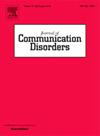失语症中协同发音动力学的声学洞察:来自闪族语言的证据
IF 2.1
3区 医学
Q2 AUDIOLOGY & SPEECH-LANGUAGE PATHOLOGY
引用次数: 0
摘要
这是第一个全面的研究,探讨了使用声学测量来表征阿拉伯语Broca失语症患者协同发音动态的可行性,解决了文献中的重大空白,并有助于对失语症中协同发音时间的普遍和文化特异性理解。五名患有布洛卡失语症的巴勒斯坦阿拉伯语参与者和五名对照组参与者完成了一项涉及初始摩擦元音音节的重复任务。使用PRAAT软件,分析结合了静态和动态声学参数,包括形成峰值(F2和F3)、过渡斜率和变异性、声音开始时间(VOT)和强度测量。统计分析发现了说话者群体之间的显著差异,布洛卡失语症患者表现出更高且更多变的形成峰值,延长且多变的VOT模式,以及降低的强度水平。密度图显示F2和F3频率分布更广,变异性增加,表明协同发音时间中断。光谱质心的降低和强度衰减速率的加快进一步突出了声学模式一致性的降低。与其他语言的研究结果相反,我们的研究结果表明,协同发音的延迟而不是完全丧失,伴随着片段转换的变异性增加。这些发现还强调了阿拉伯语独特的语音结构如何塑造协同发音动态,并促进了我们对语言代表性不足人群语音变化的理解。该研究也承认其局限性,并强调需要针对时间动态、强度模式和声音清晰度进行量身定制的干预,以加强对布洛卡失语症患者的治疗。本文章由计算机程序翻译,如有差异,请以英文原文为准。
Acoustic insights into coarticulatory dynamics in aphasia: Evidence from a semitic language
This is the first comprehensive study to examine the feasibility of using acoustic measures to characterize coarticulatory dynamics in Arabic speakers with Broca's aphasia, addressing a significant gap in the literature and contributing to both universal and culturally specific understandings of coarticulatory timing in aphasia. Five Palestinian Arabic-speaking participants with Broca’s aphasia and five control speakers completed a repetition task involving initial fricative-vowel syllables. Using PRAAT software, the analysis incorporates both static and dynamic acoustic parameters, including formant values (F2 and F3), transition slopes and variability, Voice Onset Time (VOT), and intensity measures. Statistical analysis identified significant differences between the speaker groups, with individuals with Broca's aphasia exhibiting elevated and more variable formant values, prolonged and variable VOT patterns, and reduced intensity levels. Density mapping demonstrated broader distributions and increased variability in F2 and F3 frequencies, indicating disruptions in coarticulatory timing. Decreased spectral centroids and rapid intensity decay rates further highlighted reduced consistency in acoustic patterns. Contrary to findings from studies in other languages, our results indicate a delay in coarticulation rather than a complete loss, accompanied by increased variability in segmental transitions. The findings also underscore how Arabic’s unique phonological structures shape coarticulatory dynamics and advance our understanding of phonetic variability in linguistically underrepresented populations. The study also acknowledges its limitations and underlines the need for tailored interventions targeting timing dynamics, intensity patterns, and acoustic clarity to enhance therapy for individuals with Broca’s aphasia.
求助全文
通过发布文献求助,成功后即可免费获取论文全文。
去求助
来源期刊

Journal of Communication Disorders
AUDIOLOGY & SPEECH-LANGUAGE PATHOLOGY-REHABILITATION
CiteScore
3.30
自引率
5.90%
发文量
71
审稿时长
>12 weeks
期刊介绍:
The Journal of Communication Disorders publishes original articles on topics related to disorders of speech, language and hearing. Authors are encouraged to submit reports of experimental or descriptive investigations (research articles), review articles, tutorials or discussion papers, or letters to the editor ("short communications"). Please note that we do not accept case studies unless they conform to the principles of single-subject experimental design. Special issues are published periodically on timely and clinically relevant topics.
 求助内容:
求助内容: 应助结果提醒方式:
应助结果提醒方式:


